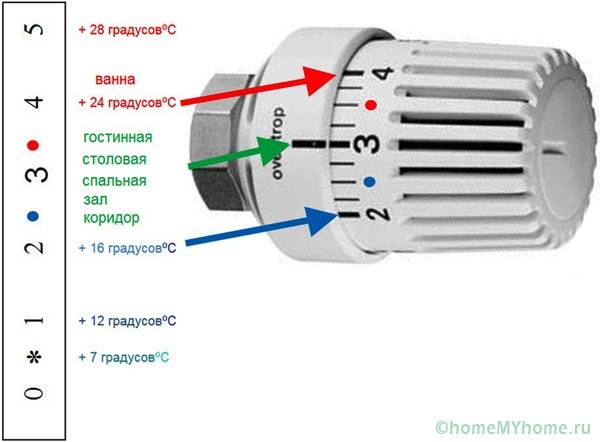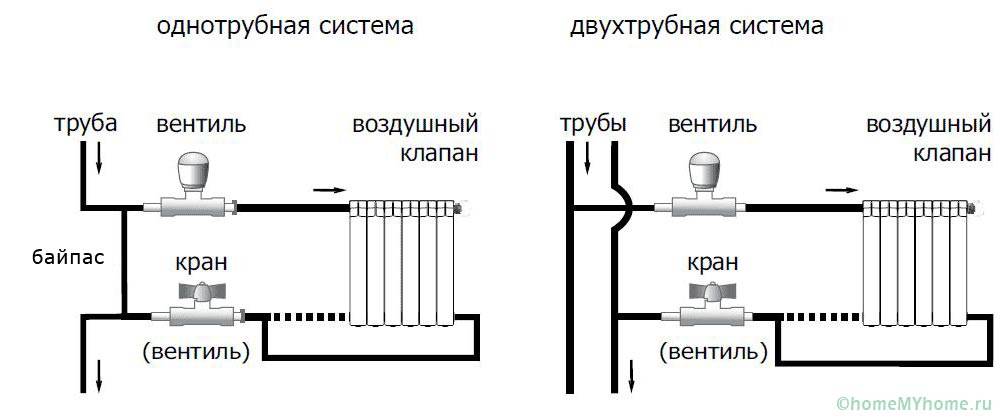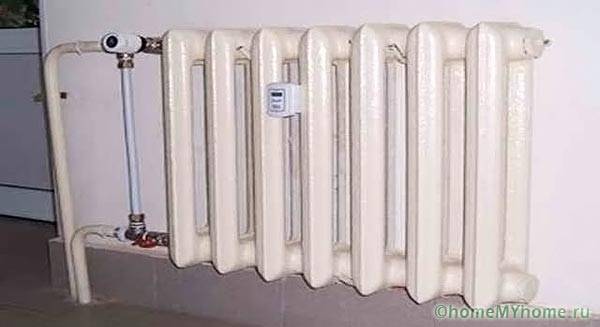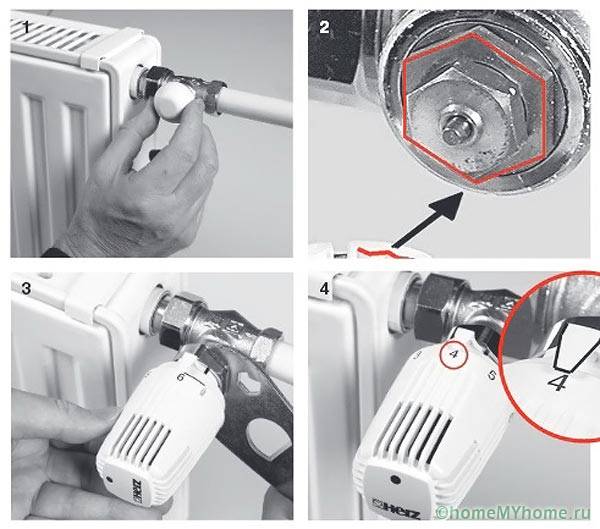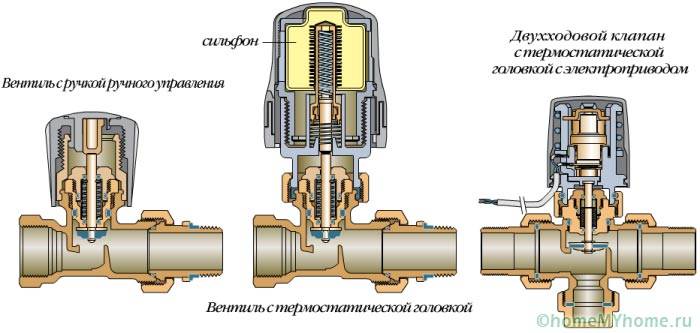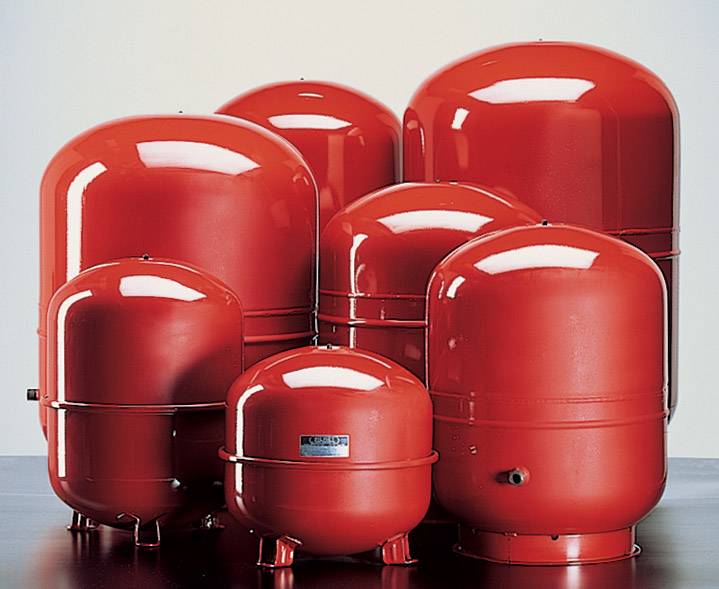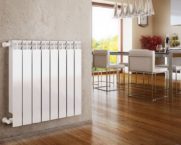Thermal head for a heating radiator: purpose and principle of operation
If it is necessary to automatically control the temperature in the interior, a thermal head for a heating radiator is used in combination with a thermostatic valve. A set of this equipment allows you to get different temperatures in each room without human intervention.
The content of the article
Video:operation of a thermostatic valve on a steel panel radiator
Classification and principle of operation
Apart from the valve, the thermal head for the heating radiator is completely useless, since there is a sensor inside it that is triggered by a change in the temperature in the room. The bellows chamber contains a solid, liquid or gaseous substance that changes the volume.
The chamber is connected to a stem that either completely closes the thermostatic valve or opens it to a regulated level. This is the main difference between a thermal valve and a control valve, which can be used to slightly reduce / add the coolant flow inside the heating register.
Attention! A thermal head for a heating radiator with a valve can only be installed in bypass systems of one-pipe systems. When the valve is triggered, the flow is completely shut off, therefore, circulation in the heating circuits stops. The bypass bypass tube completely solves the problem.
Thus, a valve is first cut into the coolant supply pipe to the heating radiator, a thermal head is screwed onto it perpendicular to the fluid flow. There are several modifications of the thermal head:
- for one-pipe systems - produced by a limited number of companies, for example, models RA-G, RTD-G from Danfoss;
- for two-pipe systems - in any store 97% of the assortment of heads are of this type.
You can visually distinguish the 2-pipe heads by the size of the adjusting cap and the color.Devices for single-pipe heating circuits are larger, have a gray, white color. Small diameter red caps fit on heads for high pressure, low flow 2-pipe systems.
Arrows on the body indicate the direction of flow of the heating medium; installation against the arrow is prohibited. Therefore, when choosing, it is necessary to take into account whether hot water flows from below or from above into the batteries of different rooms of the apartment.
The principle of operation of a thermal head for a heating radiator is extremely simple:
- the user sets the required air temperature in the room, for which there is a scale with divisions on the device (for example, 21 degrees usually corresponds to a value of 3);
- when the temperature rises by 1 degree, the substance inside the bellows chamber will heat up, increase in volume, press on the valve stem;
- the hot water supply to the battery will be completely shut off, but the circulation in the heating circuits will remain through the bypass;
- an idle register will lead to a decrease in temperature, the volume of the substance in the bellows will decrease, the pressure on the stem will disappear, the valve will open.
In this case, the technology for regulating the temperature regime of the room is effective only for radiators with minimal inertia. Bimetallic, aluminum, steel batteries cool / heat up faster, therefore they are optimal for automatic adjustments with thermal heads. Cast iron radiators take a long time to heat up, accumulate heat, cool down longer, so the efficiency of adjustments with thermal heads decreases.
Installation options and recommendations
In order for the thermal head for the heating radiator to have the maximum efficiency of regulating the microclimate in the rooms, it must be installed correctly. The main mistakes of home craftsmen are traditionally:
- vertical placement on the valve - so that the device does not stick out to the side, does not interfere with walking near the battery, wet cleaning, it is mounted vertically, while the bellows is heated by heat fluxes rising from the valve, therefore, the head should be placed horizontally outward;
- installation in niches - in confined spaces, convection decreases, heat accumulates behind curtains, under window sills, the temperature of the head is reflected incorrectly;
- installation in downdrafts at the windowsill - the bellows is intensively cooled by a draft from the window, vents, stops working.
The optimal adjustment of the thermal head for a heating radiator using an external sensor located on the walls is considered. The industry produces heads with tubes within 2 m, which allows you to normally remove the sensor from the heater, drafts from the window.
Related article:
Thermostats with air temperature sensor. A separate material provides a practical guide to the selection and installation of thermostats.
Self-installation of the thermal head on the heating radiator must be carried out on the supply line after the bypass in front of the register. For ease of use, manufacturers produce several types of heads, classified by the following characteristics:
- adjustment - manual or preliminary settings (set by a specialist plumber with a special key);
- mounting - left / right of the battery, axial, angular, straight, three-way for mounting in bypass;
- thermoelement - wall sensor, remote controller or built-in bellows;
- the working substance of the bellows - budget paraffin heads, medium-cost liquid devices, expensive gas thermoelements;
- heating system - the throughput of the heads for one-pipe systems is an order of magnitude higher.

Thermal head setting
After the user got acquainted with the design of the device, learned how the thermal head works on the heating radiator, setting the optimal microclimate in each room is not difficult. By rotating the knob relative to the scale with marks, you can adjust the temperature within the range of +5 - +28 degrees.
In the first case, the system is guaranteed not to freeze in the absence of owners inside the building of periodic operation. The maximum value is considered comfortable for users. The substance with which the bellows chamber is filled reacts to an increase / decrease in temperature within 1 degree. Therefore, the valve on / off cycles will occur regularly.
Thus, any home craftsman can choose and mount the thermal head together with the valve. To do this, it is enough to take into account the above factors, to avoid major installation errors.
Video: how to choose the right thermostatic head








